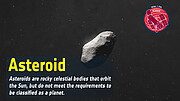Asteroid
Asteroids are rocky celestial bodies that orbit the Sun, but do not meet the requirements to be classified as a planet.
The term asteroid covers a very broad range of Solar System objects, including debris left behind by objects that did not successfully grow into planets. They are irregularly shaped, which disqualifies them from being classified as planets or dwarf planets. The asteroid belt is a region of space between the orbits of Mars and Jupiter that is densely populated with asteroids. The majority of known asteroids are found within the asteroid belt. Asteroids and comets are partially distinguished from one another by their composition: asteroids are rocky, whereas comets comprise dust and ice. When comets pass close to the Sun, some of their icy composition heats up sufficiently to be released as gas. This gas forms a loosely bound atmosphere known as a ‘coma’, and this gives comets their distinctive appearance of having a tail streaming behind them. In contrast, asteroids tend to remain solid. In practice, however, the distinction between asteroids and comets can be rather arbitrary.
Hubble has observed various asteroids over the course of more than three decades of observations. For example, in 2017 Hubble studied the asteroid Vesta — which is only 500 km in diameter — from a distance of 250 million kilometres. The observations created a map of its surface and were even able to capture the asteroid’s changing appearance as it rotated.
Hubble also observed the spectacular asteroid collision P2010/A2 in 2010. Using Hubble to study the aftermath of the collision over five months, astronomers watched a strange, comet-like debris trail slowly evolve as the collision site orbited the Sun. This research gave clues about how asteroids behave when they collide, and how the fall-out from these impacts contributes to the dust that pervades the Solar System.
In 2017 a German-led group of astronomers used Hubble to observe two asteroids, orbiting each other in the asteroid belt between Mars and Jupiter, that exhibited comet-like features, including a bright coma and a long tail. This was the first known binary asteroid to also be classified as a comet. It was Hubble’s images that revealed that it was actually not a single object, but two asteroids of almost the same mass and size, orbiting each other at a distance of about 100 kilometres. That discovery was in itself an important find; because they orbit each other, the masses of the objects in such systems can be measured. Understanding the origin and evolution of main-belt comets — asteroids orbiting between Mars and Jupiter that show comet-like activity — is a crucial element in our understanding of the formation and evolution of the whole Solar System.
In 2020, Hubble observed a rare self-destructing asteroid called 6478 Gault. The images provided new insights into the asteroid’s past: the object was 4–9 kilometres wide and had two narrow, comet-like tails of debris that indicated that the asteroid was slowly undergoing self-destruction. Each tail is evidence of an active event that released material into space. The direct observation of this activity by the Hubble Space Telescope provided astronomers with a special opportunity to study the composition of asteroids. By researching the material that this unstable asteroid releases into space, astronomers can get a glimpse into the history of planet formation in the early Solar System.



